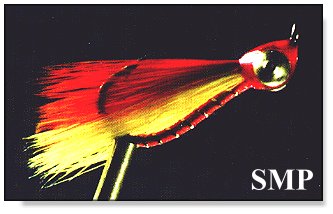Tying Instructions:
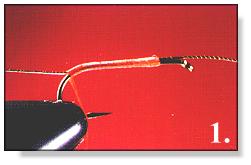
1. Start the flat waxed nylon, as you would start thread, about three quarters
up the shank. Bind the tinsel there using the pinch or a light turn. . . . Add
a few more tight turns of nylon. Lift the tinsel slightly above the shank
under moderate tension. Wrap the nylon down the shank and tinsel in
consecutive turns to partway down the bend.
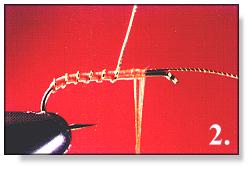
2. Wrap the nylon in consecutive turns up to its starting point (three
quarters up the shank). Wind the tinsel up the body in 6 to 10 open
spirals to create the rib. Secure the tinsel with turns of nylon, and then
trim both of its ends at the three-quarters-up-the-shank point.
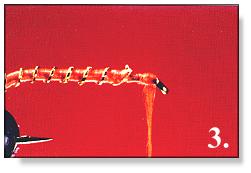
3. Build a few tight turns of nylon just behind the eye (but not blocking
it) - these turns will help keep the bead-chain eyes (or lead barbell eyes)
in place as you bind them on.
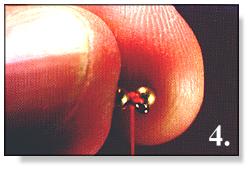
4. Cut a pair of bead-chain eyes from a chain with tin snips, the
insides of diagonal cutters, or the like (or use lead bar-bell eyes). Secure the
eyes tightly with crisscrossed turns of floss. I like to
to take a turn, hold the eyes at their sides between my thumb and first
finger, and then pull the nylon tight - but don't lose that tightness by
then letting off on the tension. The eyes should be mounted halfway
between the hooks' eye and the front of the body (which is three
quarters up the shank - remember?), in the depression between the
front of the body and the nylon buildup at the eye.
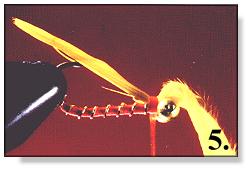
5.Invert the hook. Moisten a yellow marabou plume, and then
bind it atop the shank, just behind the bead-chain eyes, with a
few tight turns of nylon. The marabou's tips should extend about
a gape's width past the far edge of the bend.
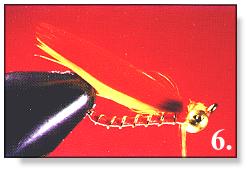
6. Bind an orange marabou plume over the yellow - same technique,
same length. Trim the butts of both plumes closely.
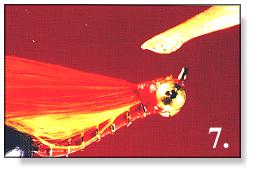
7. Cover the butts of the marabou with crisscrossed turns of nylon
between the bead-chain eyes. Whip finish the nylon just behind the
eyes and trim its end. Add expoxy generously all around the head
and bead-chain eyes (or lead bar-bell eyes.).
Variations
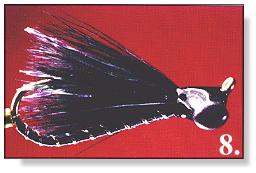
8. The Short-Strike SMP begins with a long-shank hook, 3X or 4X long
(the hook shown is a Dia-Riki 700). Wrap the nylon fully halfway down the
bend. Bind on the wing exactly as you would for the regular SMP, but the
wing must terminate at or slightly before the end of the body.
This black Short-Strike SMP has a bit of Krystal Flash in the wing. Two strands
of Krystal Flash were doubled over the thread and secured over the first marabou
plume, then covered with the second plume.
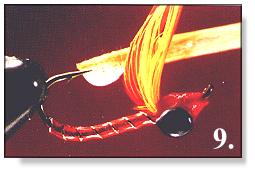
9. Forceps can cut the tinsel rib when extracting the SMP from a fish.
By wetting the wing and stroking it upwards, then coating the body with
epoxy glue, you can significantly increase the durability of the body and
rib. Epoxy or no, a bit of care when extracting the fly counts for a lot.
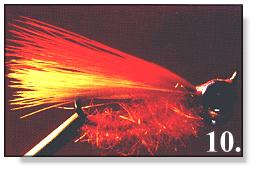
10. Another way to toughen the body of the SMP is to make the body
of shiny synthetic dubbing and omit the rib. Simply dub onto the flat
waxed nylon.
Fishing Suggestions
The most effective approach I've found is to let this fly sink to whatever
depth is appropriate, then draw it slowly and steadily back (though an
occasional shiver can't hurt), with the rod tip only an inch or two above
the water. When I feel a thump, I strike instantly (that is, my best attempt
at instantly) and hard. I sometimes let the SMP sink for only a few
seconds before working it; other times, I let it sink clear to the bottom
- it usually comes up without snagging.
The SMP resists snagging because it rides with its bend and point up.
This is due to its combination of bead-chain or lead barbell eyes mounted
atop the shank; its down-eye hook; and its wing, which is mounted
beneath the shank. Credit for this whole approach belongs to Bob
Clouser and his Clouser Deep Minnow.
As you [have] seen, there is a regular version and what I call a "Short-Strike"
version. I aways carry both. Usually I start with the regular - it has the fullest,
livelist wing, which I believe attracts the most attention. But if I am missing
strikes, which is usually because the fish are nipping only at the end of the
wing, I switch to the Short-Strike SMP. Its short wing leaves a bit of orange
body - and hook - exposed at the rear of the fly, and this will be the part
that gets nipped. ~ Skip Morris
|

